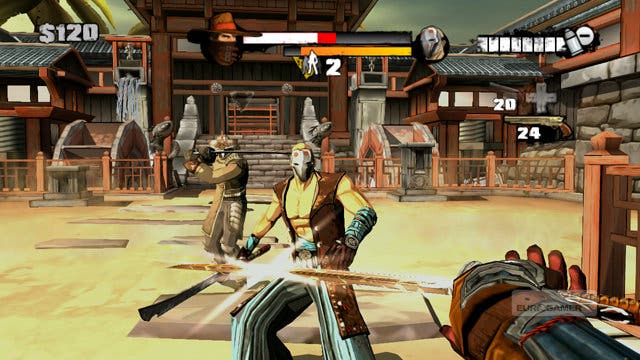Red Steel 2
Blazing waggles.
This all sounds pretty tricky. "You have no idea," says VandenBerghe, jewellery clinking as he claps his hands together. "We've done a lot of playtesting. We've been looking at what people do with the remote, then asking then what they were trying to do. We look for patterns, and then create algorithms that try to capture those patterns."
Handholding aside, MotionPlus has forced Red Steel 2's developers into something that approaches mimicry much more than the combat of most other titles does. In Zelda, to take a very early example, sword-fighting was simply about shaking the remote back and forth: it was little more than a violent take on maracas with some nice sound effects. Here you need to stand up straight, draw your arm back before swinging and really mirror the actual moves to get that katana sighing through the air for your most basic, reliable attacks.
It's a system that has made the team think about the difference between tutorials, which are good enough for most games, and actual teaching. It's a distinction that clearly fascinates VandenBerghe. "In most games, gamers already have the skill that they need to play your game," he suggests. "You move your character with one thumb, move your camera with the other thumb, and then chain inputs with buttons to cause actions. Most gamers are already good at that, so all you have to say is 'press A to do this'. Everything else is already taken care of.
"The problem that we have is, instead of 'press A' we say 'swing the sword horizontally'. Well, turns out, there are about an infinity of different ways to do that. Different angles, different forces, different degrees of movement. You can't create an algorithm that can interpret all of those different takes on the same action. That is just not doable. So we realised we were going to have to train the player in a physical skill.

"In Red Steel 2, we have to teach you the right kind of arc to swing with, and we need to actually teach you that rather than tutorialise about it. That means we have to break the action into micro-steps, and then build successes on top of each other.
"So the first thing we need to teach people is not to just swing the sword, but to actually draw your arm back first. Then we build the swing on top of that, before slowly introducing other mechanics that players have to learn physically. It's a completely different approach to just getting people to press a button. It's no longer about getting it - it's hardly complex, and everyone gets it instantly; it's about being able to actually do it too."
Based on an hour or so of slicing - and shooting - through the game's first few missions, the approach seems to be working. Red Steel 2 has a surprisingly steep learning curve, but the result is a significant improvement on the first outing.

